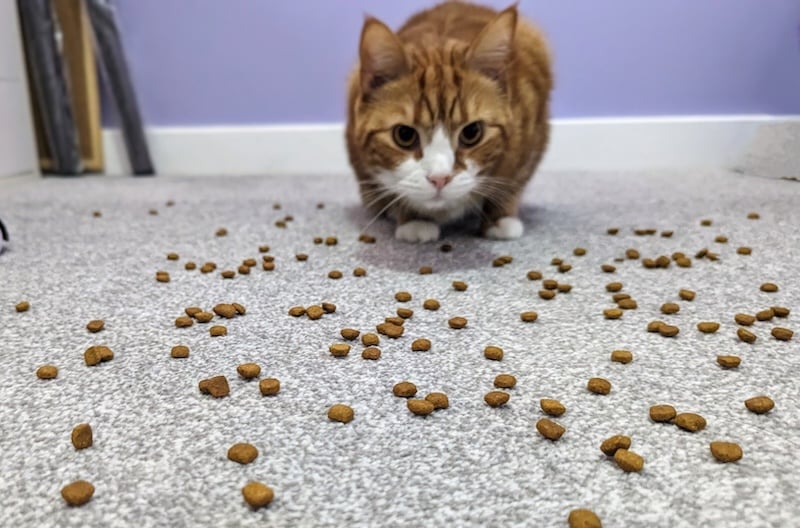If your cat keeps you awake playing in the middle of the night, you might assume that they can see in the dark. The truth is that a cat can’t see in total darkness any better than we can, which is to say not at all! So, while cats can’t actually see in the dark, they’re much better than us at making the most of whatever light there is.
Their eyes are perfectly adapted to creeping around on a night lit only by a sliver of moon. Here are eight cat night vision facts to help you appreciate your feline friend even more.

The 8 Cat Night Vision Facts
1. The Shape of Their Eye Helps Them See in Low-light Conditions
While cats can’t see in pitch-black darkness, they can see much better than we can in very low-light conditions. Thanks to their eyes’ large lens and curved cornea, they can take advantage of any light available.

2. Cats Only Need 1/6 of the Amount of Light That We Do
We might be looking around thinking it’s pitch black, but our cats can still see just fine. Their eyes can see much better in low light than ours, so cats only need 1/6 of the light that we do to be able to see.
3. Cats Have a “Mirror” in Their Eyes
This is not a real mirror, of course, but an evolutionary adaptation that achieves the same thing. Have you ever noticed that your cat’s eyes glow a green-silver color? This is the “tapetum lucidum” that sits behind the retina. This reflective layer contains 15 types of cells. It acts as a mirror to catch any light that the rods haven’t absorbed.
This means a cat’s eyes are much better at capturing available light, even in extremely low-light situations.

4. Some Cats Might Not See as Well in the Dark as Others
The tapetum lucidum is the “mirror” within a cat’s eyes that glows a green-silver color when light reflects off it. But have you noticed that some cat’s eyes glow red instead? Blue-eyed cats have a tapetum lucidum with abnormal cells, which is why they glow red and not green. It’s thought that as a result, blue-eyed cats might not see in the dark as well as cats with eyes of any other color.
5. Cats’ Eyes Contain More Rods Than Our Eyes
All mammal eyes contain rods and cones, which are cells known as photoreceptors that convert light into electrical signals that are then transmitted to our brains. Cones work best in a large amount of light, and rods are designed to work best in low-light conditions.
A cat’s eyes have more rods than a human eye, meaning it’s easier for cats to see in very low-light conditions than it is for us. Compared to our eyes, which have 80% rods and 20% cones, cats have 96% rods and only 4% cones.
Rods are also used for peripheral vision and motion-sensing—more reasons that cats are such great hunters!

6. Cats Might Be Able to See Ultraviolet Light
The light within the ultraviolet range of the electromagnetic spectrum is completely invisible to us humans because our lenses block it. Research suggests that cats and other mammals, like dogs, can actually see ultraviolet light.
Scientists are still trying to work out exactly why cats have this adaptation. It’s thought that it could be something to do with tracking their prey, but for now, the exact reason is still unclear.
- You might also like: Can Cats Have Purple Eyes? The Surprising Answer!
7. Cats’ Pupils Collect the Maximum Amount of Light
If you’ve ever looked closely at your cat’s pupils expanding and contracting, you’ll see there’s a huge range between the thin vertical line of high-light conditions and the wide-open pupil used in low-light conditions.
The shape of a cat’s pupil is better at adapting to low-light conditions. Our pupils only allow for a 15-fold increase or decrease in size. Amazingly, a cat’s pupil can achieve a 300-fold increase! So, a cat’s eyes are much better at adapting to seeing in the dark.

8. A Cat’s Eyes Inspired Reflective Road Studs
The reflective road studs that help us navigate dark country roads are known as “cat eyes” in some countries. That’s not a coincidence because their design was actually inspired by a cat’s eyes! The inventor, Percy Shaw, invented a road stud containing a small convex lens, like that of a cat’s eye. This reflects the light of your car’s headlights to you, making it easier to see where you’re going.

Additional Information:
Featured Image Credit: Mookmixsth, Shutterstock
- 1 The 8 Cat Night Vision Facts
- 1.1 1. The Shape of Their Eye Helps Them See in Low-light Conditions
- 1.2 2. Cats Only Need 1/6 of the Amount of Light That We Do
- 1.3 3. Cats Have a “Mirror” in Their Eyes
- 1.4 4. Some Cats Might Not See as Well in the Dark as Others
- 1.5 5. Cats’ Eyes Contain More Rods Than Our Eyes
- 1.6 6. Cats Might Be Able to See Ultraviolet Light
- 1.7 7. Cats’ Pupils Collect the Maximum Amount of Light
- 1.8 8. A Cat’s Eyes Inspired Reflective Road Studs
- 2 Additional Information:






